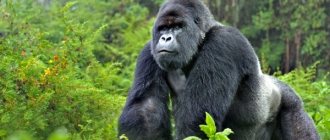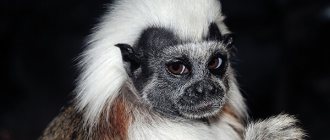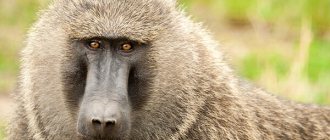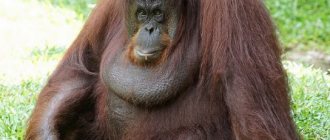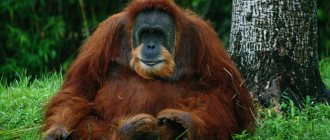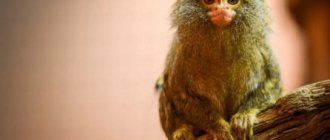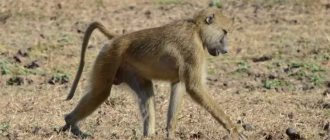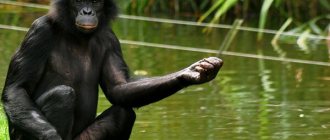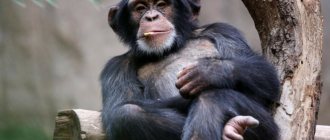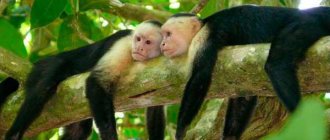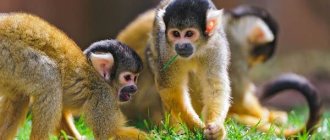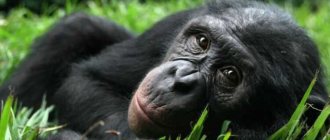Scientific classification
- Kingdom: Animalia (animals)
- Phylum: Chordata
- Class: Mammalia (mammals)
- Order: Primates (primates)
- Family: Cercopithecidae (monkeys)
- Genus: Mandrillus (mandrills)
- Species: Mandrillus sphinx (mandrill)
The mandrill is the largest monkey of the Old World, closely related to the baboon and the drill. It is noteworthy that mandrills, together with drils, were previously classified as baboons in the genus Papio (baboons). Both are now classified in the genus Mandrillus (mandrills), but all belong to the Old World monkey family.
Geographical distribution and natural habitat
Mandrills are found in southwestern Cameroon and Congo, western Gabon and Equatorial Guinea. Their distribution range is naturally limited to the Sanaga rivers in the north and the Ogowe rivers in the east.
Recent genetic studies of populations living north and south of Ogowe have shown that the differences between these mandrills are so significant that they can be considered two separate subspecies .
These shy primates live only in the tropical rainforests of equatorial Africa. They prefer dense thickets and can also be found in savannas.
Character traits
Appearance
Mandrills have a narrow muzzle, a large head with prominent brow ridges and small, close-set, sunken eyes. These primates have a stocky, compact build with long, strong limbs. Their short tail is raised all the time. The wide range of rotation of the clavicle allows the animal to climb trees, walk on all fours, and use its arms effectively. Separately located thumbs - like those of other monkeys - allow them to grasp tree branches. Both males and females also have one pair of mammary glands on their chest.
Coloring
However, the most characteristic feature of the mandrill is not its body structure, but its bright coloring . The primate's face clearly shows a narrow red stripe in the middle of the mouth and around the nostrils, which is surrounded on both sides by bright blue or purple ribbed elements. The animal also has a yellow beard and red spots around the eyes. These colors make it possible to distinguish the mandrill from the slightly smaller drill (Mandrillus leucophaeus) with completely black edges.
Photo: seasav
The rump of mandrills, especially males, also has a contrasting blue to purple coloration. On the other hand, the long fur over the entire body is olive to brown in color with lighter spots on the head, neck and belly; the eyes are framed with a black outline. Females also have colored elements on their bodies, but they are much duller and darker than those of males.
Dimensions
Mandrills have very strong sexual dimorphism - males are larger and usually weigh twice as much as females. An adult male is about 90 cm long, including the tail stump, and weighs on average 32 kg, making him the largest of all Old World monkeys. Record samples gain weight up to 54 kg! The female is much smaller, weighing on average about 12.5 kg.
- Body length: from 75 to 95 cm (males); from 55 to 66 cm (females)
- Tail length: 5 to 10 cm
- Height at the shoulders on four legs: from 55 to 65 cm (males); from 45 to 50 cm (females)
- Body weight: from 19 to 37 kg (males); from 10 to 15 kg (females)
- Average length of fangs: 4.5 cm (males); 1 cm (females)
Eating habits
Photo: pgtz
Mandrills are omnivores, but they feed mainly on plants (more than 100 species). These primates prefer fruits, as well as leaves, roots, vines, tree bark, plant fibers and mushrooms.
The mandrill's predatory nature manifests itself mainly in eating snails, beetles, insects, spiders, termites, ants, crickets and scorpions. The animal also loves to feast on other people's eggs and even vertebrates, such as birds, reptiles, turtles, amphibious frogs, porcupines, rats, shrews and other rodents. Mandrills have built-in pouches (like hamsters) for storing food for later consumption.
Mandrills sometimes hunt larger prey, such as young duikers (crested antelope) or other small ungulates. The death of the victim is most often caused by blows to the neck from long fangs, the length of which sometimes reaches 6.35 cm!
Behavior
Mandrills lead a gregarious lifestyle. They usually roam in groups of about 20 individuals led by a large male. During the dry season, their numbers can increase to 200 animals.
The power of the leader extends to all aspects of the life of primates, from waking up the pack to arranging a place to spend the night. Commands are given loudly, clearly and are supported by appropriate gestures.
After being awakened, primates climb down from the trees and walk on the ground in search of food until the evening. Young monkeys prefer to stay in the trees, jumping from branch to branch at a height of 2-5 m.
Mandrills are omnivores and happily eat nuts, fruits, leaves and flowers of many plants. The diet also includes arthropods, insects, small vertebrates, mushrooms and bird eggs. The inhabitants of mangrove forests in coastal areas hunt fish and crabs.
Primates walk on the ground on all fours. When food supplies in the “pasture” run out, the flock patiently waits for the leader’s command, and upon receiving it, happily takes off, anticipating abundant feeding. On the way, mandrills constantly call to each other so as not to get lost and disappear alone. Sometimes they organize group hunts for young small antelopes. The hunt is naturally led by a handsome leader.
Mandrills never spend the night in the same place twice. At night, a watchman is posted, who vigilantly guards the peace of the flock until dawn. In cases of danger, monkeys instantly climb trees.
Newborn mandrill cubs hang tightly clinging to the fur on their mother’s belly. Having grown stronger, they move onto their mother’s back. Babies love to play with each other and with adult females. At the age of one year, milk feeding stops and young females remain, as a rule, in their native pack, and males go on a long journey to find a place for themselves in another community.
Lifestyle
Although mandrills are excellent tree climbers, they are primarily a terrestrial species of monkey, spending most of their time on the ground. They move freely and fairly quickly on all fours and cover short distances by running on their two hind legs.
Mandrills are active during the day , during particularly hot periods they rest in shady places and sleep in trees at night. They spend every night in different places.
Mandrill monkey diet
Despite the omnivorous nature of primates, their diet is dominated by vegetation, reaching up to 92% of food consumed. The mandrill's menu includes over 110 plants with edible parts such as:
- fruits;
- leaves;
- seeds;
- nuts;
- stems;
- bark.
Mandrills obtain food both on the ground and in trees, skillfully peeling fruits and leaves.
This is interesting! Mandrills (in addition to the food they themselves obtain) do not disdain the remains of the feasts of other monkeys, for example, monkeys. The latter often have a snack in the trees, and the half-eaten pieces fly down, which is what mandrills take advantage of.
From time to time, the meal is enriched with animal protein, which is “supplied” by a variety of living creatures:
- ants and termites;
- beetles;
- grasshoppers;
- snails;
- scorpions;
- small rodents;
- frogs;
- chicks and bird eggs.
In terms of gastronomic preferences, the mandrill does not agree in everything with the baboon, which is not content with small animals, but looks for larger prey (for example, young antelopes). Often, several families gather at one time on plots with an abundant food supply. In captivity, the mandrill's menu changes somewhat . Thus, at the Moscow Zoo, monkeys are fed three times a day, serving fruits and crackers for breakfast, porridge, dried fruits, nuts and cottage cheese for lunch, and meat, vegetables and eggs for dinner.
Return to content
Social structure
Mandrills form large groups called hordes. They often number hundreds of individuals. The territory of each group can reach 50 square kilometers ! Sometimes several units gather together and travel in huge groups. The largest observed group of these animals numbered 1,300 individuals!
Groups are formed by females with young individuals. Males usually lead a solitary lifestyle and join the horde only during the females' estrus period. Each group is headed by one male leader. There is no evidence for the existence of male bachelor groups, as is the case with other animal species.
Photo: koenbetjes
Natural enemies
Thanks to the menacing appearance of males and the ability to deftly climb trees, mandrills have almost no natural enemies . The biggest threat comes from the fast and merciless leopards, which are especially easy to kill young and sick monkeys.
Return to content
Breeding season and young development
The mating season of mandrills is from June to October. Fights are possible between males, because only dominant individuals have a chance to find a partner . The strength of the mandrill is manifested, among other things, in their coloring, which becomes even brighter during the breeding season. When males are excited, the coloration of the buttock pads intensifies, and red markings often appear on the ankles and wrists.
The female can breed every two years. Pregnancy typically lasts 175 days, with births occurring between January and May. Usually one cub is born weighing 350 grams. Females care for the baby, which is attached first to the stomach and then to the back of the mother.
Photo: seasav
Newborns have pink skin and black fur . This coloring lasts until two months of age. The young become independent after a year and reach sexual maturity at the age of 4-6 years. By this time, the coloring characteristic of adults appears.
- Mating system: polygamous (harem)
- Breeding interval: every two years
- Breeding season: June to October
- Number of offspring: one cub
- Gestation period: 6 months
- Average age of sexual or reproductive maturity: 4-6 years
Links[edit]
- ^ abcdefgh Huey, Steve. "Mandrill: A Biography". AllMusic. Retrieved May 8, 2022.
- Christgau, Robert (1981). "70s Consumer Guide: M". Christgau's Recording Guide: Rock Albums of the Seventies. Ticknor and Fields. ISBN 089919026X. Retrieved March 4, 2022 - via robertchristgau.com.
- McCarthy, Jim (2004). Voices of Latin Rock: The People and Events That Created the Sound. Hal Leonard Corporation. paragraph 112. ISBN 0 634 08061-X.
- ^ ab "Mandrill US Album Chart History". allmusic.com. Retrieved September 14, 2011.
- "Mandrill IS Singles Chart History". allmusic.com. Retrieved September 14, 2011.
- ^ ab Stavans, Ilan (2014). Latin Music: Musicians, Genres and Themes
. Greenwood. p. 678. ISBN 978-0-313-34395-7. - Vincent, Ricky (1996). Funk: Music, People and the Rhythm of One. St. Martin's Press. paragraph 112. ISBN 0-312-13499-1.
- "Searching for the Mandrilland Diagram". Billboard
. Retrieved June 15, 2022. - Lowen, Lars. "We Are One: An Overview". AllMusic. Retrieved May 8, 2022.
- "Back to Town". The Mandrill Experience
. Archived from the original on January 31, 2022. Retrieved February 23, 2022. - "NEW ALBUM COMING OUT SOON" . MANDRILL
. Retrieved July 16, 2022. - ^ a b "Mandrill Bio". Mandrill Music
. Retrieved February 23, 2022.
Lifespan
In the wild, mandrills live 20 years; in captivity, they can reach 31 years of age. The natural enemies of mandrills are:
- leopard;
- African crowned eagle;
- one of the varieties of African python.
Photo: Kitty Terwolbec
They can also be killed by the bite of a viper that they accidentally step on. However, researchers believe that most predators pose a threat only to young mandrills; the risk of becoming prey for adults decreases as they grow older.
Although mandrills are primarily arboreal monkeys, the only factor that forces most of the group to hide in the treetops is a leopard attack. Although even in this case, dominant males often remain on the ground to demonstrate their strength.
Save Status
Since 1978, the IUCN has listed the mandrill as a vulnerable species. An accurate count of the total population has not been made because most individuals are elusive . However, environmentalists believe that mandrill populations have declined by as much as 30% since 1978!
Mandrills are endangered mainly due to human activity - destruction of the natural environment (deforestation for agricultural land and human settlements) and overhunting, especially in the Congo. Many Africans consider their meat a delicacy . Unfortunately, the reintroduction of these primates (raised in captivity and later released into the wild) has not yet been successful.
Although mandrills are protected in Lopé National Park, a 4,910-square-kilometre Gabonese nature reserve, and other protected areas, environmentalists are stressing the urgent need for a comprehensive population census of these colorful primates.
Discography [edit]
Studio albums[edit]
- Mandrill
(1970) - Mandrilla Island
(1971) - Composite truth
(1973) - Just outside the city
(1973) - Mandrilland
(1974) - Solid
(1975) - Beast from the East
(1976) - The Greatest
(with George Benson) (soundtrack, 1977) - We are one
(1978) - New worlds
(1979) - Getting in the mood
(1980) - Energy
(1981) - Live in Montreux
(2002) - Back to town
(2020)
Collections [edit]
- Best of Mandrill
(1975) - Renaissance
(1992) - Fencewalk: An Anthology
(1997) - Best collection
(2000) - sunlight
(2005)
Singles and EPs [edit]
- Peace and Love
(EP, 2001) - "Driving While Black and Brown" (single, 2001)
- "Pre-Nuclear War Blues" (single, 2004)
- "Sunshine" (soundtrack, 2004)
